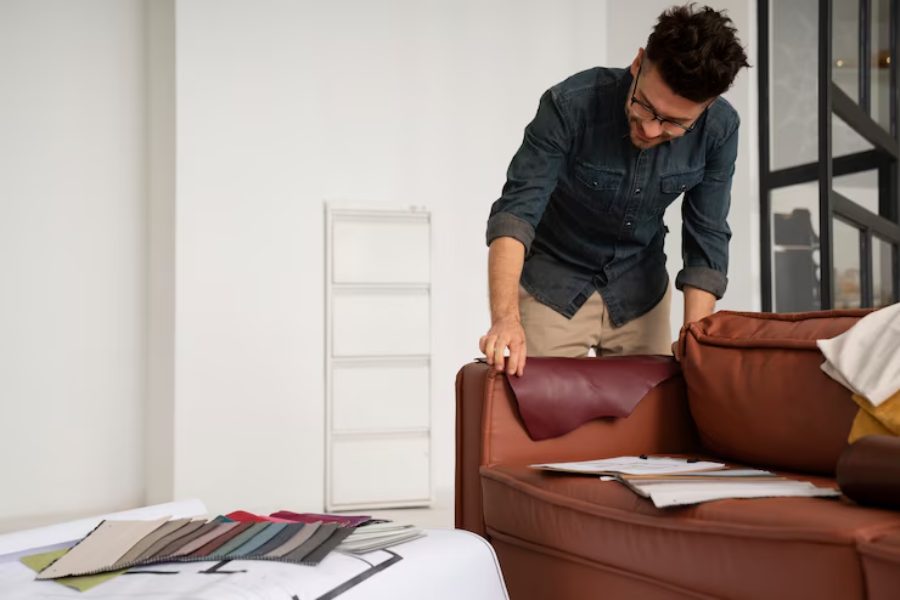Upholstery plays a vital role in the comfort, aesthetics, and longevity of furniture—but what is the purpose of upholstery, exactly? At its core, upholstery refers to the craft of applying padding, cushioning, and fabric or leather coverings to a furniture frame. It’s the process that transforms a bare structure into a piece that’s not only comfortable to sit on but also visually appealing and suited to its environment.
The purpose of upholstery goes far beyond surface beauty. While the fabric cover creates a first and lasting impression—especially in homes, offices, and commercial settings—the materials beneath the surface are equally important. These hidden components determine the ergonomics, durability, and overall quality of the furniture. High-quality upholstery supports your posture, enhances usability, and elevates interior design.
Key to upholstery’s effectiveness is the selection of textiles. Factors like the Martindale rating—which tests a fabric’s resistance to wear—along with considerations like fire retardancy, ease of application, and fabric texture, all influence performance over time. Upholstery must not only complement a furniture piece visually but also withstand daily use and environmental stressors.
In this article, we’ll explore the full scope of what is the purpose of upholstery, from its history and functional significance to its impact on health, comfort, and style in both residential and commercial spaces.
What is the purpose of upholstery?
Upholstery enhances the comfort, aesthetics, and functionality of furniture. It cushions seating surfaces, protects the furniture structure, and adds a layer of personal style. From luxury sofas to ergonomic office chairs, upholstery contributes to long-lasting use and visual appeal.
The Historical Roots of Upholstery
Upholstery has a long-standing history dating back to ancient civilizations. Egyptians used animal skins and rudimentary materials to pad their seats, while the Greeks and Romans embraced more refined textiles and craftsmanship. In the Middle Ages, upholstery became increasingly ornate, created primarily for royalty and nobility. By the Renaissance, techniques had grown more sophisticated, and during the Victorian era, upholstered furniture became a symbol of wealth and personal taste.
As techniques evolved, so did the materials—shifting from natural fillers like horsehair and straw to advanced foams and synthetic blends used today. This evolution wasn’t merely technological; it reflected profound social changes. As the middle class grew, upholstered furniture became more accessible, turning from exclusive luxury to a household norm.
Modern homes, hotels, and even public transport now rely heavily on upholstered pieces. As demand surged, so did the need for regular care, leading to the rise of professional upholstery cleaning service providers to maintain cleanliness and extend furniture lifespan.
Understanding upholstery’s historical context reveals its layered purpose: not just utility, but a reflection of art, comfort, culture, and personal identity. Today, it continues to enhance our environments while staying rooted in centuries of craftsmanship and innovation.
Why Does Upholstery Matter in Modern Furniture?
Upholstery plays a crucial role in the design, comfort, and functionality of modern furniture. From aesthetics to acoustics, its impact goes far beyond fabric choice.
Comfort and Ergonomics
One of the primary reasons upholstery remains vital in modern furniture is its significant role in providing comfort and ergonomic support. With advancements in materials like memory foam, variable-density cushions, and breathable contour fabrics, upholstery helps reduce physical fatigue, particularly in seating. Whether it’s a desk chair or a living room sofa, the quality of the upholstery can directly impact posture, spinal alignment, and long-term physical well-being.
Visual Appeal and Interior Aesthetics
Upholstery is also a powerful tool for enhancing visual appeal and setting the tone of a space. Designers and homeowners alike use different fabrics, patterns, and textures to complement or contrast interiors. Upholstered furniture adds depth, warmth, and personality to any environment—whether it’s a sleek modern office or a cozy reading nook.
Structural Protection
Beyond looks, upholstery serves a practical purpose by protecting the underlying frame and internal mechanisms of furniture. The padded layers act as a barrier against impact, dust, and daily wear, which significantly extends the functional lifespan of each piece.
Customization and Branding
Upholstery offers immense flexibility in customization. Commercial spaces frequently match upholstery with their brand colors or design language. In residential settings, it allows homeowners to express individuality and taste through fabric selection and furniture design.
Sound Absorption Qualities
Finally, upholstery plays a subtle but valuable role in acoustics. Heavily upholstered pieces such as wall panels and headboards can absorb ambient noise, helping to create quieter, more comfortable environments—especially in urban or shared spaces.
Essential Functions of Upholstery in Everyday Living
Upholstery plays a pivotal role in both the performance and appearance of furniture. It transforms a simple wooden or metal frame into something functional, comfortable, and visually appealing. Below are the most impactful functions upholstery delivers in modern design and lifestyle:
- Comfort Enhancement: Upholstery adds layers of cushioning—like foam, batting, and springs—that soften the hard structure of furniture, making seating or lounging far more pleasant.
- Style Expression: Through color, texture, and fabric patterns, upholstery becomes a design statement. It can match interior themes, highlight trends, or reflect personal or brand identity.
- Durability Boost: Upholstered layers act as a protective shield over the furniture’s core frame. They reduce the wear and tear from daily use, ultimately extending the lifespan of the furniture.
- Temperature Control: In both hot and cold climates, upholstery helps insulate furniture surfaces, making them more comfortable to sit on year-round.
- Health Support: Ergonomically designed upholstery supports posture and spinal alignment, especially in work or lounge settings where extended sitting is common.
- Noise Reduction: Thick, upholstered surfaces absorb ambient noise and echo, improving acoustics in residential or commercial spaces.
These combined benefits explain why upholstery is essential—not just for comfort, but also for form, function, and wellbeing.
How to Choose Upholstery That Serves Your Needs
Choosing the right upholstery starts by defining what matters most to you—comfort, durability, or style. For high-traffic furniture such as sofas or dining chairs, durable materials like microfiber, synthetic blends, or treated leather are ideal, offering resistance to wear, stains, and daily stress. In contrast, if you’re furnishing a formal living room or statement space, upscale fabrics like velvet, suede, or silk can elevate the look, though they often require more care. Allergy sufferers or those living in humid climates should also consider hypoallergenic and breathable textiles like cotton or linen.
Maintenance plays a vital role in long-term satisfaction. Some fabrics are easy to clean at home with removable covers or stain-resistant finishes, while others demand regular professional upkeep. Ultimately, upholstery should align with your lifestyle, environment, and design goals. The perfect fabric enhances not only the function of your furniture but also the comfort and visual harmony of your space.
What Is the Purpose of Upholstery in Commercial Spaces?
Upholstery plays a strategic role in commercial environments, going beyond just appearance to directly impact customer experience, branding, and functionality. Below are five core purposes that make upholstery a vital element in business settings:
- Enhancing Customer Experience: In spaces like cafes, hotels, and salons, plush and well-padded seating creates a welcoming atmosphere. Comfortable upholstery encourages guests to stay longer, leave positive reviews, and return more frequently, making it a subtle but powerful business asset.
- Creating Brand Identity: Custom upholstery allows businesses to showcase their unique brand identity through textures, colors, and patterns. A well-upholstered space aligned with the brand palette reinforces recognition and creates a cohesive visual experience.
- Improving Acoustics: Large commercial areas such as hotel lobbies or coworking spaces often suffer from echo. Upholstered wall panels, booths, or dividers absorb sound, helping maintain a quieter and more pleasant environment for conversations and productivity.
- Meeting Safety Standards: Commercial upholstery often comes with fire-retardant finishes and adheres to safety regulations for high-traffic environments. This ensures both customer safety and compliance with legal codes.
- Facilitating Maintenance: Stain-resistant fabrics, modular components, and removable cushions make cleaning and repairs much easier, reducing downtime and maintenance costs.
Final Remarks
When exploring the question, “What is the purpose of upholstery?” the answer reaches far beyond just aesthetics. Upholstery plays a vital role in enhancing comfort, elevating design, and providing essential functionality in both residential and commercial spaces. From improving posture and reducing noise to reflecting personal style or brand identity, its influence is felt in everyday living. Upholstery turns cold, rigid furniture into warm, welcoming pieces that invite relaxation and productivity. As materials continue to evolve and customization becomes more accessible, the role of upholstery will only grow more significant. It’s not just about covering a chair—it’s about enriching the human experience through thoughtful design and practical application. Upholstery, simply put, is a modern necessity.
FAQ’s
What is upholstery made of?
Upholstery is composed of multiple layers including padding, supportive springs, webbing, and an outer fabric or leather covering that adds both comfort and style.
Can upholstery improve health?
Yes, especially when ergonomically designed. Upholstery can support better posture, reduce spinal stress, and contribute to overall physical well-being during prolonged use.
How long does upholstery last?
With routine maintenance and depending on material quality and frequency of use, upholstery can typically last anywhere from 7 to 15 years or even longer.
Is upholstered furniture easy to clean?
Many modern upholstery options feature stain-resistant finishes or removable, machine-washable covers, making them very convenient to clean and maintain.
What is the most durable upholstery fabric?
Leather, tightly woven microfiber, and synthetic blends are among the most durable, making them ideal for homes with kids, pets, or high foot traffic.










